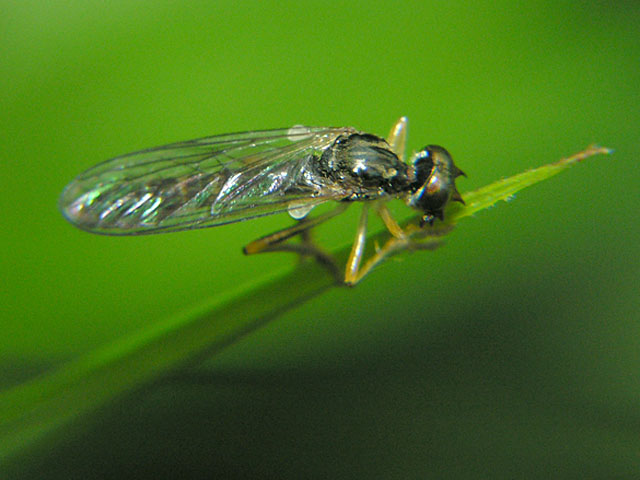Diptera.info :: Family forums :: Asilidae Forum
|
it is not Baccha elongata - for 100%
|
|
| Robert Heemskerk |
Posted on 29-05-2006 00:10
|
|
Member Location: Amsterdam, Netherlands Posts: 2082 Joined: 17.10.05 |
hi Asilidaeforum, This afternoon I got surprised when I watched one of some Baccha elongata more closer.. I discovered that the fly I saw was (for 100%) not a Baccha elongata - it's was a Asilidae sp. - it was a quite long, elongated fly with spines on the fronthead!, like the devil.. I can say a pretty one  what kind of 'devil'-Asilidae is this? greeting Robert, Robert Heemskerk attached the following image:  [82.75Kb] Edited by Robert Heemskerk on 29-05-2006 00:11 |
| Robert Heemskerk |
Posted on 29-05-2006 00:12
|
|
Member Location: Amsterdam, Netherlands Posts: 2082 Joined: 17.10.05 |
devil from above)
Robert Heemskerk attached the following image:  [79.75Kb] Edited by Robert Heemskerk on 29-05-2006 00:13 |
| Jan HC Velterop |
Posted on 29-05-2006 00:45
|
|
Member Location: Enschede NL 7544 ZE 106 Posts: 56 Joined: 08.03.06 |
On first sight one would think of Dioctria hyalipennis but the coxae are completely yellow, just like legs 1 and 2, and the abdominal segments have a yellow posterior margin. The border between the parts of the thorax that are pollinose are sharp, too. Sandy soils. Mark van Veen 1996 does not mention Amsterdam, but there must be some forest edges on sandy soil. Jan Velterop |
|
|
|
| Robert Heemskerk |
Posted on 29-05-2006 22:26
|
|
Member Location: Amsterdam, Netherlands Posts: 2082 Joined: 17.10.05 |
Hello Jan,  I think the coxae of Dioctria linearis are yellow, this fly fits also more in the biotope (wet forest) What is your idea about Dioctria linearis? And about the face of this fly.., that isn't normal?!, something must have happened.. greeting Robert, Edited by Robert Heemskerk on 29-05-2006 22:28 |
| Jan HC Velterop |
Posted on 30-05-2006 17:18
|
|
Member Location: Enschede NL 7544 ZE 106 Posts: 56 Joined: 08.03.06 |
Hello Robert, you're right. I have seen the coxae too and intended to state: D. linearis, but my text did not come through correctly, this being my first intervention. As with the face of the fly: it seems to be an abnormal development of the head in the pupa. It doesn't look like damage by some predator. If you have collected it, you should be able to see, if not it has died naturally! Regards, Jan. |
|
|
|
| Paul Beuk |
Posted on 30-05-2006 18:58
|
|
Super Administrator Location: Netherlands Posts: 19403 Joined: 11.05.04 |
I wonder if the head was maybe struck by a drop of water, it looks a kind of soaked, explaining the 'thorns': hairs sticking together.
Paul - - - - Paul Beuk on https://diptera.info |
| Eric Fisher |
Posted on 30-05-2006 20:36
|
|
Member Location: California Posts: 435 Joined: 19.05.06 |
Robert, Jan: This poor Dioctria (linearis seems a correct ID) is a victim of some accident that happened when the adult was emerging from the pupal case. The head portion of the pupal case failed to split open properly, so the adult retained this structure (a chitin mask). The biggest pair of "thorns" are the antennal sheaths. Regards, Eric |
|
|
|
| Paul Beuk |
Posted on 30-05-2006 20:53
|
|
Super Administrator Location: Netherlands Posts: 19403 Joined: 11.05.04 |
Aaaahhhhh! You are right, of course!
Paul - - - - Paul Beuk on https://diptera.info |
| Kahis |
Posted on 30-05-2006 20:57
|
|
Member Location: Helsinki, Finland Posts: 1999 Joined: 02.09.04 |
Even the flies have Lordi monster masks these days Eric, I hindsight that's obviously what has happened here. Well spotted. I have never seen this kind of accident before. Edited by Kahis on 30-05-2006 20:57 Kahis |
| Robert Heemskerk |
Posted on 02-06-2006 08:30
|
|
Member Location: Amsterdam, Netherlands Posts: 2082 Joined: 17.10.05 |
Thanks a lot for unmasking this phantom  Next time I prefer to see a normal one! greeting Robert, |
| Jump to Forum: |













